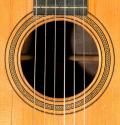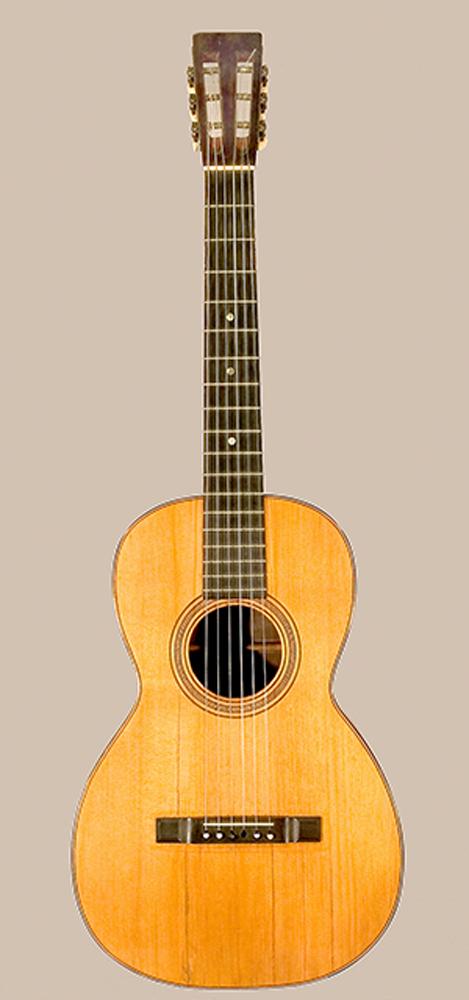Advanced Search
Plucked Strings
Guitars
Guitar
Maker: C. F. Martin & Co.
Date: 1867 - 1885 ca.
Place Made:New York, New York, United States, North America
Model: 1-21
Serial No: none
SignedBranded on back graft: [lettering curved downward at each end] C.F.MARTIN & Co [sic] / ―∙― / NEW_YORK [sic]
Branded on back of head: [lettering curved downward at each end] C.F.MARTIN [sic] / NEW-YORK
Branded on back of head: [lettering curved downward at each end] C.F.MARTIN [sic] / NEW-YORK
MarkingsPrinted on paper label affixed to neck block, the date written in black ink: REPAIRED BY / A. A. DORN, / SPRINGFIELD, / March 13-1894MASS. [sic]
Written in pencil on back graft: FINN / 2/28/23
Written in pencil on back graft: FINN / 2/28/23
DescriptionThough small by today’s standards, the Martin Model 1-21 was a medium-sized guitar for the 19th century. Designed for home use, guitars such as NMM 3441 were not required to have the volume and projection that characterized later Martin guitars used for public performance. This instrument bears the 1894 repair label of Arthur A. Dorn, who is listed as a carpenter in the 1890 Springfield, Massachusetts, directory. Dorn was born in New York about 1855, and grew up working on the family farm in Beekman, Dutchess County. NMM 3441 also bears the repair inscription of John Finn, from whose wife Laurence Witten bought the guitar in 1968.
Stringing: six gut strings
Soundboard: two-piece spruce, medium grain broadening toward the flanks
Back: two-piece book-matched Brazilian rosewood; back stripe comprised of alternating strips of light and dark hardwood forming herringbone pattern, with very narrow light hardwood purfling strip through center, the herringbone surrounded on each side with two strips of light hardwood and one strip of dark hardwood purfling
Ribs: two-piece Brazilian rosewood divided by ebony end graft strip (slightly wider toward top than bottom) surrounded by light and dark hardwood purfling (2 strips) on each side
Head: slotted, mahogany peghead veneered with rosewood
Neck: mahogany with ridge along center of back; flared heel
Heel cap: ebony
Binding: rosewood with four strips of alternating light and dark hardwood purfling strips, the two outer strips wider than the two inner strips; back binding later black celluloid with single light hardwood purfling strip
Fingerboard: ebony, possibly later; 18 nickel-silver frets; single abalone dots behind 5th, 7th, and 10th frets
Nut: ivory
Bridge: ebony, later, with chamfered, raised squares at each end; bone saddle; ebony bridge pins with abalone eyes
Pegs: two sets of steel and brass worm-gear machine heads with brass rollers, ivory heads, the plates stamped with sprigs of oak with acorns, geometric borders, with two bull’s-eyes at each end
Endpin: ebony with abalone eye
Rosette: alternating strips of light and dark hardwood forming herringbone pattern, with very narrow light hardwood purfling strip through center, the herringbone, surrounded on each side by two rings comprised of two strips of light hardwood and one of dark hardwood (3 strips each), with natural wood in between
Varnish: clear
Linings: kerfed mahogany
Neck block: mahogany; chamfered corners
End block: mahogany; chamfered corners; maple graft at center, perpendicular to top and back
Top braces: spruce X-brace, the joint of main cross brace reinforced with gray canvas; maple bridge plate
Back braces: spruce back graft; four spruce back braces, the two braces in the lower bouts with rounded edges, and wider and lower in height than the two braces in the upper bouts
Stringing: six gut strings
Soundboard: two-piece spruce, medium grain broadening toward the flanks
Back: two-piece book-matched Brazilian rosewood; back stripe comprised of alternating strips of light and dark hardwood forming herringbone pattern, with very narrow light hardwood purfling strip through center, the herringbone surrounded on each side with two strips of light hardwood and one strip of dark hardwood purfling
Ribs: two-piece Brazilian rosewood divided by ebony end graft strip (slightly wider toward top than bottom) surrounded by light and dark hardwood purfling (2 strips) on each side
Head: slotted, mahogany peghead veneered with rosewood
Neck: mahogany with ridge along center of back; flared heel
Heel cap: ebony
Binding: rosewood with four strips of alternating light and dark hardwood purfling strips, the two outer strips wider than the two inner strips; back binding later black celluloid with single light hardwood purfling strip
Fingerboard: ebony, possibly later; 18 nickel-silver frets; single abalone dots behind 5th, 7th, and 10th frets
Nut: ivory
Bridge: ebony, later, with chamfered, raised squares at each end; bone saddle; ebony bridge pins with abalone eyes
Pegs: two sets of steel and brass worm-gear machine heads with brass rollers, ivory heads, the plates stamped with sprigs of oak with acorns, geometric borders, with two bull’s-eyes at each end
Endpin: ebony with abalone eye
Rosette: alternating strips of light and dark hardwood forming herringbone pattern, with very narrow light hardwood purfling strip through center, the herringbone, surrounded on each side by two rings comprised of two strips of light hardwood and one of dark hardwood (3 strips each), with natural wood in between
Varnish: clear
Linings: kerfed mahogany
Neck block: mahogany; chamfered corners
End block: mahogany; chamfered corners; maple graft at center, perpendicular to top and back
Top braces: spruce X-brace, the joint of main cross brace reinforced with gray canvas; maple bridge plate
Back braces: spruce back graft; four spruce back braces, the two braces in the lower bouts with rounded edges, and wider and lower in height than the two braces in the upper bouts
DimensionsTotal guitar length: 954 mm (37-9/16″)
Back length: 479 mm (18-7/8″)
Upper bout width: 236 mm (9-5/16″)
Waist width: 189 mm (7-7/16″)
Lower bout width: 322 mm (12-11/16″)
Rib height (including edging) at heel: 87 mm (3-7/16″)
Rib height, at waist: 93 mm (3-21/32″)
Rib height, at end block: 104 mm (4-3/32″)
Head length: 163 mm (6-7/16″)
Head width, top: 71 mm (2-13/16″)
Head width, bottom: 50 mm (1-31/32″)
Neck length (nut to ribs): 317 mm (12-1/2″)
Neck width, nut: 47 mm (1-27/32″)
Neck width, heel: 58 mm (2-9/32″)
Soundhole diameter: 91 mm (3-9/16″)
Vibrating string length (nut to bridge edge): high E: 632 mm (24-7/8″); low E: 631 mm (24-13/16″)
Back length: 479 mm (18-7/8″)
Upper bout width: 236 mm (9-5/16″)
Waist width: 189 mm (7-7/16″)
Lower bout width: 322 mm (12-11/16″)
Rib height (including edging) at heel: 87 mm (3-7/16″)
Rib height, at waist: 93 mm (3-21/32″)
Rib height, at end block: 104 mm (4-3/32″)
Head length: 163 mm (6-7/16″)
Head width, top: 71 mm (2-13/16″)
Head width, bottom: 50 mm (1-31/32″)
Neck length (nut to ribs): 317 mm (12-1/2″)
Neck width, nut: 47 mm (1-27/32″)
Neck width, heel: 58 mm (2-9/32″)
Soundhole diameter: 91 mm (3-9/16″)
Vibrating string length (nut to bridge edge): high E: 632 mm (24-7/8″); low E: 631 mm (24-13/16″)
ProvenancePreviously owned by Lawrence Witten, who purchased it from Mrs. John Finn in 1968.
Terms
Credit Line: Witten-Rawlins Collection, 1984
Not on view
Published ReferencesJoseph R. Johnson, Mandolin Clubs and Orchestras in the United States (1880-1920): Their Origin, History and Instruments, M.M. Thesis (Vermillion: University of South Dakota, 1987), pp. 60-61,135. Joseph R. Johnson, "The Mandolin Orchestra in America, Part 3: Other Instruments," American Lutherie, No. 21 (Spring 1990), pp. 48-49. Joseph R. Johnson, “The Mandolin Orchestra in America,” The Big Red Book of American Lutherie Volume Two, 1988-1990, (Tacoma, Washington: Guild of American Luthiers, 2000), pp. 273-274.
Object number: 03441












